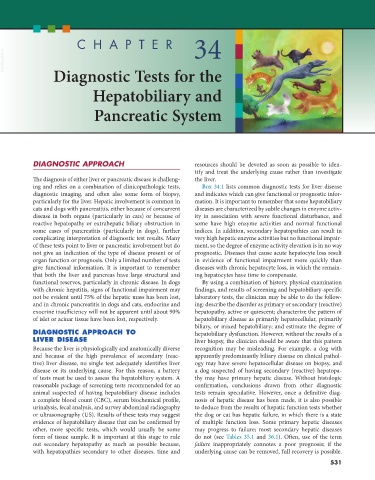Page 559 - Small Animal Internal Medicine, 6th Edition
P. 559
CHAPTER 34
VetBooks.ir
Diagnostic Tests for the
Hepatobiliary and
Pancreatic System
DIAGNOSTIC APPROACH resources should be devoted as soon as possible to iden-
tify and treat the underlying cause rather than investigate
The diagnosis of either liver or pancreatic disease is challeng- the liver.
ing and relies on a combination of clinicopathologic tests, Box 34.1 lists common diagnostic tests for liver disease
diagnostic imaging, and often also some form of biopsy, and indicates which can give functional or prognostic infor-
particularly for the liver. Hepatic involvement is common in mation. It is important to remember that some hepatobiliary
cats and dogs with pancreatitis, either because of concurrent diseases are characterized by subtle changes in enzyme activ-
disease in both organs (particularly in cats) or because of ity in association with severe functional disturbance, and
reactive hepatopathy or extrahepatic biliary obstruction in some have high enzyme activities and normal functional
some cases of pancreatitis (particularly in dogs), further indices. In addition, secondary hepatopathies can result in
complicating interpretation of diagnostic test results. Many very high hepatic enzyme activities but no functional impair-
of these tests point to liver or pancreatic involvement but do ment, so the degree of enzyme activity elevation is in no way
not give an indication of the type of disease present or of prognostic. Diseases that cause acute hepatocyte loss result
organ function or prognosis. Only a limited number of tests in evidence of functional impairment more quickly than
give functional information. It is important to remember diseases with chronic hepatocyte loss, in which the remain-
that both the liver and pancreas have large structural and ing hepatocytes have time to compensate.
functional reserves, particularly in chronic disease. In dogs By using a combination of history, physical examination
with chronic hepatitis, signs of functional impairment may findings, and results of screening and hepatobiliary-specific
not be evident until 75% of the hepatic mass has been lost, laboratory tests, the clinician may be able to do the follow-
and in chronic pancreatitis in dogs and cats, endocrine and ing: describe the disorder as primary or secondary (reactive)
exocrine insufficiency will not be apparent until about 90% hepatopathy, active or quiescent; characterize the pattern of
of islet or acinar tissue have been lost, respectively. hepatobiliary disease as primarily hepatocellular, primarily
biliary, or mixed hepatobiliary; and estimate the degree of
DIAGNOSTIC APPROACH TO hepatobiliary dysfunction. However, without the results of a
LIVER DISEASE liver biopsy, the clinician should be aware that this pattern
Because the liver is physiologically and anatomically diverse recognition may be misleading. For example, a dog with
and because of the high prevalence of secondary (reac- apparently predominantly biliary disease on clinical pathol-
tive) liver disease, no single test adequately identifies liver ogy may have severe hepatocellular disease on biopsy, and
disease or its underlying cause. For this reason, a battery a dog suspected of having secondary (reactive) hepatopa-
of tests must be used to assess the hepatobiliary system. A thy may have primary hepatic disease. Without histologic
reasonable package of screening tests recommended for an confirmation, conclusions drawn from other diagnostic
animal suspected of having hepatobiliary disease includes tests remain speculative. However, once a definitive diag-
a complete blood count (CBC), serum biochemical profile, nosis of hepatic disease has been made, it is also possible
urinalysis, fecal analysis, and survey abdominal radiography to deduce from the results of hepatic function tests whether
or ultrasonography (US). Results of these tests may suggest the dog or cat has hepatic failure, in which there is a state
evidence of hepatobiliary disease that can be confirmed by of multiple function loss. Some primary hepatic diseases
other, more specific tests, which would usually be some may progress to failure; most secondary hepatic diseases
form of tissue sample. It is important at this stage to rule do not (see Tables 35.1 and 36.1). Often, use of the term
out secondary hepatopathy as much as possible because, failure inappropriately connotes a poor prognosis; if the
with hepatopathies secondary to other diseases, time and underlying cause can be removed, full recovery is possible.
531

